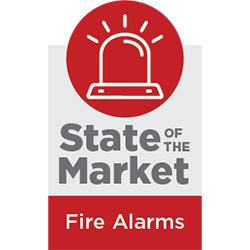2020 was a tough year in the fire market for many. Improvements in technologies and the impending cellular sunset came up against supply chain issues and a talent shortage that made it a difficult-to-meet demand.
When questioned on the state of any market in the past year, people seem unsure of how to answer. Like many areas of the security industry, fire alarm services became increasingly important, while the task of providing these services became more difficult than ever.

“COVID-19 brought the safety and security of buildings to the forefront like never before,” says Dick Bauer, vice president of sales for NOTIFIER, Honeywell Fire, Honeywell Building Technologies, Atlanta. “While this extends beyond fire systems, they are part of the bigger picture when it comes to how all the systems in a building should be working towards creating a healthier and safer environment. This past year and a half also helped accelerate the need for a technological revolution in the fire industry, which as a whole has been slower to implement new technologies. The industry needs new technologies to better support our customers and the challenges they face.”
Carl Lynch Pelaez, senior national business development manager at Mircom, Toronto, is also impressed by the recent technological advancements in the fire market.
SDM asked, “How would you rate the current state of the market for fire alarm/emergency communications?”
“While technology in general has rapidly advanced, the fire alarm industry has always lagged behind other industries in terms of technology available and approval of agencies such as NFPA,” Pelaez says. “Today, with companies such as Ring, you can be alerted if someone comes in or around your residence or dwelling, and have a live or prerecorded image streamed on your smart phone. Meanwhile, when it comes to life safety, wireless transmission of an activation to a central monitoring center has most recently been approved and accepted versus using traditional phone lines or POTS lines, which are virtually nonexistent in today’s world.”
Unfortunately, the past year also saw a great deal of delayed or canceled projects. Best Defense Fire Protection & Security Inc., Waunakee, Wis., saw a 25 percent decrease in business in 2020. Company President Carter Rierson credits this to delayed projects and high prices from vendors.
Many of these delayed projects from 2020 had lasting effects felt largely in the first quarter of 2021.
“COVID-19 delayed lots of projects that were active and it delayed projects coming out in the future,” says Eric Garner, CEO and president of Mountain Alarm, Ogden, Utah. “Q1 was the worst for fire installation in four years. It was a timing issue of jobs not being awarded during COVID-19 finally catching up. Q2 through Q4 should be banner quarters for fire install.”
According to SDM’s 2021 Industry Forecast, 37 percent of security professionals consider the state of the fire alarm market to be very good or excellent, while 41 percent consider it to be good, and 21 percent believe the state of the market is poor or fair.
Revenue Change Expectations
SDM asked in 2020, “Compared to this year, how do you expect your company’s revenue in each of the following categories to change next year?”The percent of respondents that predicted fire alarm/ emergency communications revenue would grow in 2021 was 15 percentage points lower than predictions for the previous year. However, most respondents didn’t expect it to decrease. // SOURCE: SDM 2020 AND 2021 INDUSTRY FORECAST STUDIES
The Forecast also found that just a third of security professionals are expecting an increase in revenue from fire alarm products and services in the next year.
But not everyone had a bad year. Custom Alarm in Rochester, Minn., saw a 10 percent increase in sales revenue coming from fire alarm systems in 2020 over 2019.
Supply Chain Struggles
One especially impactful and long lasting effect of the pandemic has been massive supply chain issues that have affected almost every industry.
“The pandemic created some worldwide supply chain issues for components, not only for security, but for automotive, computing and all kinds of electronic industry,” NAPCO’s Judy Jones-Shand says. “At the very same time we’ve seen heightened demand from both the cellular sunsets for 3G/CDMA and POTS lines elimination. Additionally, more and more dealers have also standardized on cellular, and StarLink or FireLink for all their installations. While these factors are fueling demand, it makes forecasting and procurement difficult. Fortunately we have continued to meet the challenge and deliver the products needed to keep our dealers working to meet their deadlines and customer commitments.”
Melissa Brinkman of Custom Alarm says that slow production and the even slower delivery of products has been the greatest impact of COVID-19 on business.
“We have seen extensive product shortages over this last year that have been blamed on limited raw materials as well as delays due to COVID-19 and anything from labor issues to freight problems and everything in between,” Brinkman says. “Due to these significant delays in production, we have increased our purchasing of fire alarm system products in anticipation of longer lead times. We will likely continue to do this until the manufacturers are able to get back to regular product levels, and lead times are more reasonable.”
Material shortages and the delays they cause in getting a system completed is the greatest challenge integrators face this year, Potter Signal’s Craig Summers says.
“COVID-19 has dramatically impacted the ability to source materials,” Summers explains. “Our procurement team has worked around the clock to make a very bad situation tolerable for Potter and our customer base.”
Carter Rierson says that his team at Best Defense has increased stocking levels and started placing orders earlier to ensure they can deliver projects to customers on time.
Mircom is also taking measures to combat supply chain woes. The company will be opening an additional manufacturing facility and plans on doing everything possible to increase productivity and source additional suppliers of raw materials to fulfill product needs.
“In 2020, [we saw] an increase of 5 percent in securing sales orders and purchase orders from our customers,” says Mircom’s Carl Lynch Pelaez. “However, it has been challenging to fulfill the orders in a timely manner.”
Though much of these supply chain issues may be out of security professionals’ hands, companies are doing their best to keep end users happy.
“To date, 2021 has continued to be a strong year despite ongoing complexities due to the pandemic,” says Jon Hughes of Kidde. “While we expect some further challenges for the remainder of the year, we have been working to take actions to mitigate supply chain uncertainty as best as possible.”
“We have focused on continuing to develop relationships with local electricians to include our fire alarm systems in new builds throughout Southeastern Minnesota,” says Custom Alarm CEO Melissa Brinkman.
“However, we also believe we would have seen an even more significant upsurge in fire alarm sales had it not been for COVID-19. We had a significant number of jobs that were put on hold or just completely canceled due to businesses shutting down.”
With the surplus of fire alarm system jobs, Custom Alarm invested in its operations department and added two more fire alarm technicians to the team in 2020.
78%
The percentage of security professionals who consider the state of the fire alarm market to be excellent, very good or good. // Source: SDM 2021 Industry Forecast
“Even though there were months of 2020 that had fewer fire alarm system installations, we focused on training and meeting with end users to go over new opportunities in the fire alarm market,” Brinkman explains. “This has already helped us experience above average sales revenue increases in 2021.”
Through the first six months of the year, Custom Alarm had already exceeded the total revenue earned from fire alarm system installations in all of 2020.
“Overall, the fire market continues to have good fundamentals,” says George Brody, president of Telguard, Atlanta. “Construction, building upgrades, code requirements and landline cutting all contributed to a growth market. … COVID-19 in the fire industry and specifically Telguard has actually produced something positive. We confirmed and accelerated our remote support and service capabilities, both from elements in the products, as well as how to support our fire dealers and integrators. … Even with the overall slowdown that the entire economy went through in the second quarter of 2020 due to the pandemic, the second half of the year bounced back strong with a double digit increase over 2019.”
The Cellular Sunset
The 3G cellular sunset is fast approaching, bringing opportunity for those in the fire alarm market.
“The cellular network sunset provides the single largest opportunity for manufacturers of alarm system communicators to grow their business,” says Warren Hill, vice president of marketing at Alula, St. Paul, Minn. “We have high expectations for 2021 and 2022.”
“To meet needs around the sunset, manufacturers are pushing their latest and greatest communicators. Alula is entering the fire market for the first time in Q4 2021 with its new BAT-Fire Communicator.
“Meanwhile, NAPCO is celebrating the 20th anniversary of its StarLink Fire Communicator, and continues to update the popular product to meet sunsetting needs.
“ “In direct response to customer feedback, we continued to innovate, adding many feature benefits that are geared toward improving the installation process, such as quick connect FACP jacks and self-supervision circuits,” says NAPCO’s Judy Jones-Shand. “Coupled with the NAPCO quality and StarLink dual-antenna coverage performance, StarLink Fire has become the choice of more and more dealers. It was so popular, in fact, that we built StarLink Cellular communications into our Gemini Commercial FACPs and created the multi-award-winning FireLink Panel Series — and this year, we added onboard dual path communications, cell/IP communication options and cloud-based programming. Dealers have told us it’s a game changer.”
“Ultimately, navigating this sunset could present a challenge for integrators, though.
“ “Systems integrators will be faced with finding the time and the trained technicians that can help upgrade the backlog of alarm systems that need to be upgraded,” Hill says. “Combine that with the fact that commercial markets continue to grow and the need for fire alarm systems along with it, and now you have a situation where systems integrators may have to choose between taking care of existing customers and growing their clientele with new system installations.
“ “If we’ve learned anything over the last 18 months, specifically about business operations, it’s to not procrastinate. We’re working with hundreds of alarm system integrators that are feeling the crunch to get alarm panel communicators upgraded before the old cellular networks are retired. Many of these dealers weren’t dragging their feet on upgrading systems — they simply weren’t planning on a pandemic that would significantly inhibit their ability to get out into the field to make necessary upgrades. The inability to readily get into businesses in a completely open fashion has reduced the window of opportunity we had to upgrade systems.”
Improvements in the Market
Slowly but surely, the technologies in the fire alarm market are moving into the future.
“Overall, we’re going to see a shift in the market away from your grandma’s fire alarm, to solutions that are much more tech savvy,” Bauer says. “We’re seeing new products that offer cloud connections, which enables faster alarm transmission times and much more data being made available to the central stations, and in turn, the first responders.”
Honeywell has joined other fire companies in introducing a self-testing smoke detector to the market recently. According to Bauer, this self-testing detector reduces the time needed for system commissioning, testing and inspections, because while a traditional smoke alarm test requires technicians to physically introduce smoke to the detector, the technician can test this alarm simply by establishing a near field connection and activating the detector’s self-test feature.
This self-test meets the same NFPA and UL requirements as traditional inspection methods, but can be completed in a fraction of the time, Bauer adds.
“Solutions like self-testing smoke detectors will be disruptive to the fire market,” Bauer says. “These products reduce the number of technicians needed on site and cut the test and inspection process by close to half. Better yet, [because] technicians can execute inspections from outside the room, it’s saving facility managers and occupants the hassle of unwanted interruptions. These kinds of technologies have the potential to revolutionize the way fire and life safety systems are installed, tested and maintained, and will move the needle for the industry as a whole.”
Brinkman also predicts that self-testing detectors will soon surge in popularity.
“Devices capable of self-testing via an addressable panel will have a significant impact in the coming years,” she says. “Our manufacturer is looking at releasing these in both photo electric smoke detectors and duct smoke detectors. As the fire alarm panels are becoming more advanced and intelligent, it gives us the opportunity to sell more value to the customers as these are smart devices communicating more information, allowing a more efficient way to know when there is an issue, earlier.”
In 2020, Minnesota adopted a new fire code that largely affected the education vertical market. Brinkman says that this led to many area schools to seek to move to a new voice evacuation system. In addition, the schools wanted Custom Alarm to incorporate lockdown and weather alerts into the fire alarm system as an added value and functionality for safety.
“Moving forward, our fire alarm vendor (NOTIFIER) is almost ready to release a new addressable panel that will be modular in design,” Brinkman says. “Additionally, this panel will be utilizing cloud software via a gateway that interfaces to a fire alarm system panel or network. This will allow our technicians and fire alarm inspectors to connect to a panel remotely or onsite via Bluetooth.”
Some of the advantages of this include streamlining commissioning, increasing service productivity and accessing reports at any time, from anywhere.
“Cloud-based services that create value for integrators and building owners will play a big part in the fire alarm market in the years to come,” says Craig Summers, vice president of sales at Potter Signal, St. Louis. “This will provide more detailed information about the fire alarm system to more stakeholders on a much quicker basis.”
Jon Hughes, vice president of marketing and product manager for Kidde Engineered Systems, Bradenton, Fla., believes that the implementation of UL 268 7th Edition for Smoke Detection will have a big impact on the future of the market. The standard’s implementation was delayed twice during the pandemic, but it is supposed to go into effect next year. Hughes predicts that it will drive new systems to a higher level of performance against synthetic fire and nuisance sources.
Adding Fire Services
SDM asked, “Are you offering, or planning on offering, fire alarm products and services
Of those not currently offering fire alarm products and services, 22 percent have plans to start offering them within five years. // SOURCE: SDM 2021 INDUSTRY FORECAST STUDY
“We expect this will be especially well received in the hospitality, multi-family, condo and dormitory markets,” Hughes says. “We continue to see interest and growth in voice evacuation systems and mass notification or incident management solutions. And because most fire alarm installations are unique to the building they are protecting, systems that offer flexible network and audio designs, along with energy efficient devices, will make it easier for project managers to meet their requirements efficiently and cost-effectively.”
It has been a challenge for standards bodies such as UL and the NFPA to keep up with the rapid advancing of technology during a global pandemic, Mircom’s Pelaez says.
“The fire alarm industry has many agencies such as UL that must approve product prior to the sale of the product,” Pelaez explains. “Additionally, today’s fire products are driven with software and firmware. UL has also been directly affected by COVID-19 in terms of manpower and social distancing requirements; therefore, the approval process has dramatically slowed down. Engineers who write and develop software and firmware are working from home and do not have the normal collaboration with their colleagues that they would otherwise have if working in the office. Both factors contribute to a slowdown in new product deployments and R&D.”
An Inside Look at the NFPA’s Year
Like any other office, the National Fire Protection Association (NFPA) had to close its doors and send employees to work from home once the COVID-19 pandemic hit the U.S.
Here, NFPA Staff Liaison Richard Roux gives a glimpse at what the past year was like at NFPA, and what he observed of COVID-19’s impact on the fire alarm market:
“COVID-19 played a real important part in 2020 and 2021. New York was setting the precedent when it came to alarms, and they came to the point where they didn’t want to send their fire department inspection personnel into the field to do any inspections or finals on anything for fear of their employees getting the virus, and we really had a lot of things to cope with regarding that. We ran into a lot of problems early on in 2020 where buildings weren’t being properly inspected and were being delayed because of COVID-19 and these types of precautionary activities. So we really had a big problem, and the problem quickly spread to other areas across the country, and no one wanted to put their fire department in contact with people moving around.
“That created a tremendous amount of turmoil, and I’m not sure a lot of people really realize. And then of course it went on a bit longer, and places like New York were shutting down construction activities because they didn’t want those workers affected. So now we have all these places shutting down, and construction sites are a ripe opportunity for fires and disasters. When stuff is stored in these locations — cleaning agents, fuel for generators — they put a fence around the site and lock the door, but homeless people move in, and you get more fires. We were seeing people coming out of the woodwork, putting together webinars and info on safely winding down a construction site. And six months later, everything was coming back up again and we were moving.
“We at NFPA shut down in March of last year; they closed the building and everybody worked from home — that was the safe and prudent thing to do. But we came back, and one thing that was a real savior was technology. We did more Microsoft Teams meetings in the past year and a half than we probably ever will in the future — we did meetings with 60 people on the call to keep the ball in the air. NFPA, in addition to being a standards developer, we’re a printing house with a warehouse. After a while we figured out how to get people back into the office, so even though we couldn’t physically ship books out, we could download them. Technology helped us along the way, and this was true of the whole industry. A lot of the seminars, meetings and classes [the industry has put on] have all been virtual. I used to teach five seminars a year with 25 people each — I didn’t do any of that last year, but we still did it virtually, and now we’ve taken most of our live learning into online avenues. Necessity is the mother of invention, and we’ve done a lot of things that keep us flourishing.”
The Future of Fire
Despite the pause in business that the pandemic forced on many, industry insiders see the future of the fire alarm market as strong.
“We continue to expect to continue to take great strides in the fire alarm technology we provide and see great growth in the marketplace” says Judy Jones-Shand, vice president, marketing, NAPCO Security Technologies, Amityville, N.Y. “Fire and life safety are critical areas where application expertise, like NAPCO has, is key. … We expect continued growth in sales, as well as many exciting new product offerings in the commercial fire space.”
Now, particularly for security integrators and dealers, the challenge is finding employees to meet the demand.
“One of the biggest challenges integrators are currently facing is finding and securing skilled labor,” Bauer says. “Not only is the industry struggling with the realities of the current limited labor market, but as the latest fire product solutions level up, so do the skillsets of the personnel needed on site. It becomes more difficult to find qualified people to do the job. Technicians now need to understand how the technology works, how to program it and how to interact with it.”
Bauer adds that Honeywell is working to create solutions aimed at making the jobs of integrators easier and more efficient in order to help ease this issue.
“We’ve made a fundamental switch to get back to basics in training and certification,” says Carter Rierson of Best Defense. “As the labor force continues to tighten, we need to focus on internal growth of entry-level techs to mid-level, and mid-level to advanced.”
Best Defense is expanding its training lab to include a full two-riser sprinkler system to train technicians on sprinkler monitoring system installation, programming and testing.
“Opportunity is everywhere — there is no shortage of work,” says Mountain Alarm’s Eric Garner. “Our biggest challenge is keeping and finding good technician labor.”
Pelaez says that one reason for this problem is a shortage of schools that train students on fire alarm installation. “The majority of schools that do provide any sort of fire alarm training are a small part of electricity training and only cover cable runs, sizing cable properly, resistance, ACDC theory, etc. Mounting devices, programming and code requirements are not covered. Many fire alarm companies have opted to train in-house; however, this is very time consuming, costly and no guarantee of success. Moreover, many coming out of school headed into the workforce do not want to be a tradesman, therefore potential tradesmen are at an all-time low.”
Still, Pelaez is optimistic for the rest of 2021.
“Provided COVID-19 is put to rest or at least under control, the market will be strong,” he says. “I believe Q4 2021 will close strong in terms of orders being placed. It is yet to be seen if the supply chain issues will ease up; however, they should with most of the workforce whom are currently out of work returning to work.”






